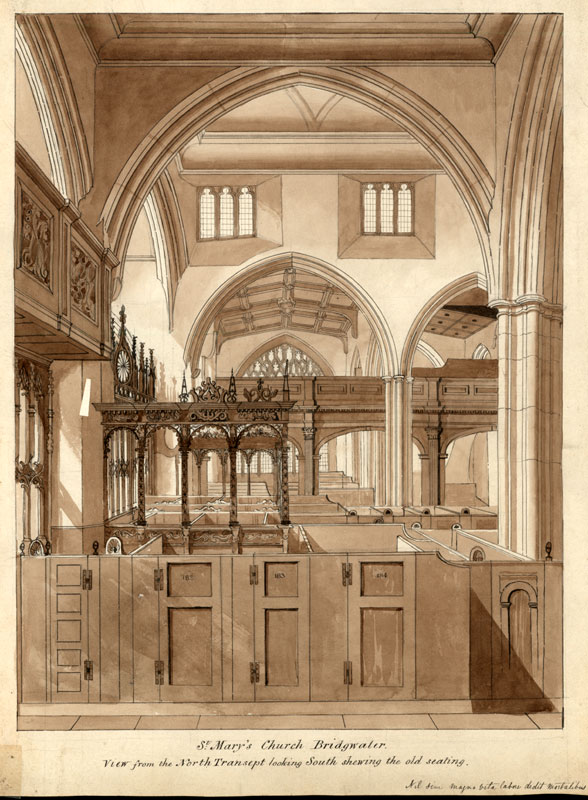Fourteenth or Early Fifteenth Century Rood Scrreen, St Mary’s Church, Bridgwater.

Between 1782 to 1786 Edmund Rack (1735?-1787) was actively engaged in making a topographical survey of Somerset. After his death the work was published by the Rev. John Collinson in 1791 in three volumes. His MS report on St Mary’s included:
The chancel is divided from the nave and ayles by a curious open work Gothic screen, over which is an organ loft with a large fine toned organ in the center and gallerys to right and left. In the front of this gallery are the royal arms and 12 other coats in the pannels of the wainscot, belonging to the families who subscribed to the organ.’
The Royal Arms is presumably the one now on the tower wall at the west end of the nave.
This organ appears to have survived quite well, only needing repair in 1810, and it remained in that position in the church until 1823. It was then decided to dismantle it and rebuild it in the new gallery being erected at the west end of the nave, under the western arch, where it effectively blocked the draught from the tower arch.
Rack’s account suggests the rood screen was very similar to the one surviving today at Westonzoyland Church. Organs placed on the rood screen in parish churches seem to have been rare: they were more common in cathedrals. One survivor is in All Saints church, St Ives, Cambs, which can be seen here.
The following lithograph of 1834, undoubtedly by the younger John Chubb, shows the rood screen behind the front screen of the corporation pews. It must have remained until the reordering of the 1850s. The Corporation screen stands in front of the rood screen, and the parish clerk’s desk is to the right of the pulpit at ground-floor level. The pulpit was 2 pillars forward of where it is today.

Two watercolours of the chancel arch area are in Exeter City Library made by the Devon architect Edward Ashworth (1814 – 1896) showing before and after views of the work. This view of from the North Transept. At the front are the doored box pews of the Nave, then to the left the Gallery of the North Chapel. Then is the side view of the Corporation Screen, and in the distance the South Transept Gallery.


By permission the South West Heritage Trust: West Country Studies Library, Exeter.
Ref: P&D15001
It has usually been assumed that the two fourteenth/early fifteenth-century carved screens on the north and south sides of the chancel are the old rood screen, having been cut in two during the 1850s restoration. This was the assertion of Sydney Gardnor Jarman in the 1880s, although Thomas Bruce Dilks was less certain of this in the following generation.


These screens contain ten interesting monograms, although the significance of these is currently unknown. They may have something to do with the ‘12 other coats in the pannels of the wainscot, belonging to the families who subscribed to the organ’ described by Rack, although from this description we might expected fully painted heraldic panels set upon the screen.


This is the only surviving medieval screen in Bridgwater. There was a second, discovered in the Cupola, a building situated opposite the church in St Mary Street, which is now in St Donat’s Castle in South Wales. This screen was clearly salvaged from a church. It may have come from the Franciscan Friary, which survived into the 1640s, the Hospital of St John in Eastover, the Chapel of St Mark in Bridgwater Castle, or perhaps from a side chapel within St Mary Church.

Tony Woolrich 25 September 2020. Pictures of the Rood Screens kindly taken by Richard Philpott
